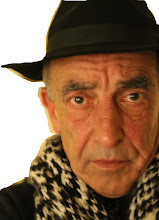I still have the record of my first lessons of history at school when I was nine years old. It is something we would today call a notebook. Most of it was written exactly according to the instructions of our teacher. But some things were not. One could say that they contained my first personal interpretation of history, by way of my illustrations.

Charlemagme at his court in the early 800's (TKA 1961)
These drawings are a reflection too of that time. The man with the firm stride closely resembles a popular comic figure, Captain Haddock of Tintin, whom I was frantically copying in all my drawings and scribbles. Of course, history obtains its meaning very much because we can project ourselves into it. Experience it.

Captain Haddock (Herge)
I have to say that the largest share of my history lessons did not come from school, but from my father, and from many other people, family and friends, teachers, with whom I shared the years of my youth.
At school our teacher picked this notion up by starting her lessons right there, with the experience of family: young people, old people, stories from the past, long ago, a chain – a chain of people and a chain of ‘time, endlessly going back in the past.
The first page of my notebook, the first lessons, dealt with this concept of time, and the timeline you can divide in parts, in dates. All of it was quite clear for me from the onset.

The first page of my history notebook, fourth grade (age 9)
I believe that in order to understand this space of time in the past’ and people long gone, the idea of a finite life, and thus the notion of death, must be clear by that time too, in any child of nine years old. I certainly understood it because I had no difficulty to grasp the implication of old aunts and uncles, even a grandfather, already having ‘died’.
The notebook is not simply a annotation of dates. It contains many references to the way of life of the people, their circumstances, their technologies and livelihood, next to the significant facts of history and the kings, queens, presidents and Popes involved in them.

The professions, the crafts and the arts also were given their proper attention, even in ‘experience’ terms. One example is the letter ‘P’ that I designed for the cover of an imaginary Medieval book, dedicated to a person named Philip.
Why not? It is a good way to experience the dedication of a 10th Century Monk who is working on his masterpiece. That monk would have loved the availability of Photoshop or 3D design, or even mass produced tubes of paint. But in his time they didn’t have any of it.

Viking ship
But I believe it was the key lesson of my father that stirred my passion for history indefinitely. He was always very quick to relate events of our time to examples in the past. And once that happens, you get interested to hear the whole story, and not just the fragments. It comes naturally if you have the basic curiosity of a child.
It has to be fed, this curiosity. It is the curiosity that does not develop just on its own steam. I believe that our current youngest generation is one which shows a good deal of curiosity, and I believe it is critical that we help them answer it in the right way.
For me, the lessons of history have most of all been part of an expedition of my own. I was given ample opportunity to actively absorb it, in our travels, in movies, in books, in family history. It continues to be such expedition to this day. Every day when I travel to certain periods or aspects of history, I largely see facts which I already ‘know’, but I see them in different lights and contexts. And this includes the events of which I had been witness myself, such as the revolution of the sixties.
The active exercise of history is a highly useful effort especially on behalf of our present and future. Not by way of prediction, but by way of projection and interpretation. Every day we absorb these lessons.
My perceptions of Charlemagne and the Vikings, and many other figures of the past have since evolved, of course. Most of all I have many more questions about Charlemagne than ‘knowledge’. And it is unlikely that today I would paint a Viking ship so colorful. But otherwise, the picture is very constant too. The order of history as I grasp it today is founded on these very basic lessons, back almost fifty years ago.



1 comment:
Theo, you were a wonderful artist then, as now! Can you please make me a medieval H? What strength you have in both the right and left lobes of your brain.
Post a Comment